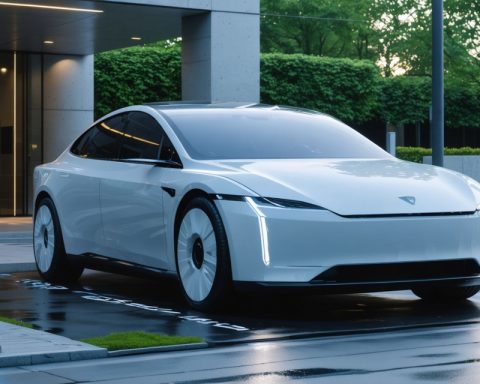- New York’s power system is undergoing a pivotal transformation, aiming to drastically cut fossil fuel reliance through the New York Climate Leadership and Community Protection Act.
- The state targets a 40% reduction in gas emissions by 2030 and 100% zero-carbon electricity by 2040, yet faces potential challenges of energy shortages by 2033.
- Renewable energy sources like wind and solar, although key to this vision, present challenges due to their intermittent nature and demand for a resilient power grid.
- Economic hurdles such as supply chain disruptions, rising construction costs, and inadequate transmission infrastructure challenge the integration of renewables.
- Community resistance to projects creates additional complications, reflecting the tension between local interests and state-wide environmental goals.
- Governor Kathy Hochul’s balancing act between green initiatives and energy reliability epitomizes the broader societal challenge of achieving sustainable energy.
Beneath New York’s towering skyline lies a power system on the brink of change — one that could redefine the very essence of energy consumption in one of the world’s most iconic cities. The ambitious push to replace fossil fuel with renewable energy has unearthed a challenging landscape, where the promise of clean energy collides with the stark realities of a complex and evolving power infrastructure.
The New York Climate Leadership and Community Protection Act, an audacious vision set forth in 2019, aims for the Empire State to dramatically decrease fossil fuel reliance, cutting gas emissions by 40% by 2030 and achieving 100% zero-carbon-emission electricity by 2040. Yet, the recent report from the New York Affordable Clean Power Alliance casts a shadow on this green horizon, warning that the rapid transition might lead to a labyrinth of challenges fraught with the possibility of energy chaos.
Like the formidable city itself, New York’s energy demands are unrelenting. The report forewarns a shortfall in power generation as early as 2033 if current plans proceed unchecked. This potential gap looms as an obstacle to the state’s forward march toward sustainability, driven by an increase in peak demand and the gradual phasing out of reliable fossil fuel generation.
The allure of wind and solar, with their capacity to harness the gentle whispers of the wind and the sun’s radiant beams, remains tempered by their unpredictable nature. These sources, while clean, are inherently intermittent — subject to the whims of weather patterns and daylight cycles, demanding a resilient and adaptable grid to maintain equilibrium in real-time energy supply and demand.
Even beyond nature’s caprices, a tangled web of logistical barriers threatens progress. Supply chain disruptions, escalating construction costs due to inflation, and surging interest rates have formed a trifecta of economic pressures that are squeezing developers and utilities alike. The rising tide of costs is further catalyzed by prohibitive expenses associated with connecting renewable sources to New York’s existing grid, a problem amplified by inadequate transmission infrastructure to ferry electricity from energy-rich upstate regions to the densely populated urban core.
Not all opposition lies within technical or economic domains; the human element injects an additional layer of complexity. Projects like Lighthouse Wind and the Hecate Energy Solar project have faced fierce community resistance, reshaping or ending plans even after years of negotiations and adjustments. The push and pull between local concerns and state ambitions create a microcosm of larger struggles between immediate community interests and long-term environmental benefits.
Governor Kathy Hochul, standing at the policy crossroads, maintains a delicate balance between accelerating New York’s green initiatives and ensuring energy reliability and affordability. As debates intensify, the governor’s challenge is emblematic of a wider societal struggle: pushing the boundaries of what’s possible in sustainability without dimming the lights on modern conveniences and economic pragmatism.
As New York stands as a beacon of ecological aspiration, the path forward requires deft navigation through a landscape where innovation meets resistance, and ambition wrestles with practicality. The state’s journey into a renewable future could serve as a roadmap for others, illuminating both the possibilities and pitfalls of green energy transformation on a massive scale.
Is New York’s Green Energy Transition on the Verge of a Crisis?
In its quest to transition from fossil fuels to renewable energy, New York is navigating a complex landscape fraught with challenges and opposition. Here’s an in-depth look at the various aspects that shape this ambitious transformation:
How-To Steps & Life Hacks for Supporting Renewable Energy Transition
1. Efficient Energy Use: Implement energy-efficient practices at home and work to reduce overall demand.
2. Incentives and Subsidies: Take advantage of government rebates and incentives for solar panel installations and energy-efficient appliances.
3. Community Engagement: Get involved in community discussions about local renewable projects to ensure balanced outcomes.
Real-World Use Cases
– Battery Storage: California’s use of battery storage to manage peak solar production demonstrates the potential for energy storage to complement intermittent renewable sources like wind and solar.
– Microgrids: Communities in Alaska are pioneering microgrids that allow them to function independently from the primary grid, enhancing local energy resilience.
Market Forecasts & Industry Trends
– Investment in Grid Infrastructure: Significant investments are expected in upgrading grid infrastructure to handle renewable energy integration. The global grid modernization market is projected to grow significantly in the next decade (Grand View Research).
– Electrification: Increased electrification of transport and heating is expected to drive up electricity demand, necessitating advances in renewable capacity and grid reliability (International Energy Agency).
Controversies & Limitations
– Intermittency Issues: The unpredictable nature of wind and solar power necessitates backup systems or energy storage solutions, which increase costs. Debate continues over the feasibility of over-relying on intermittent sources.
– Community Pushback: Opposition can delay or halt projects, as seen with the Lighthouse Wind project in New York, leading to calls for better community consultation and involvement.
Features, Specs & Pricing
– Wind Turbines: Modern wind turbines can generate upwards of 3-4 MW of power, depending on location and technology, with prices ranging from $1.3M to $2.2M per MW (National Renewable Energy Laboratory).
– Solar Panels: Costs have plummeted over the decade, with the average installation cost hovering around $2.60 to $3.00 per watt in New York (Solar Energy Industries Association).
Security & Sustainability Considerations
Ensuring grid security during this transition period is a top priority. Cybersecurity measures are crucial as more smart and connected devices are integrated into the grid, making it susceptible to cyber threats.
Insights & Predictions
– Energy Storage: Energy analysts predict a massive surge in energy storage deployment, essential for stabilizing renewable energy supplies (BloombergNEF).
– Distributed Grid Systems: There’s a compelling shift toward distributed energy resources and smart grid technologies, enhancing flexibility and reliability (Rocky Mountain Institute).
Pros & Cons Overview
Pros
– Environmental Benefits: Reduced carbon emissions and improved air quality.
– Long-Term Cost Savings: Reduced energy costs in the long run with mature renewable technologies.
– Job Creation: New opportunities in green technology sectors.
Cons
– Initial Costs: High initial investment for infrastructure and technology upgrades.
– Regulatory Hurdles: Navigating complex regulations can delay project timelines.
– Intermittency Issues: Dependence on weather conditions for power generation.
Actionable Recommendations
1. Adopt Energy Efficiency Measures: Reduce consumption through energy-efficient appliances and practices.
2. Support Local Renewable Projects: Engage with community initiatives for renewable energy adoption.
3. Stay Informed: Follow updates on state policies and incentive programs to make informed decisions about personal energy use.
If New York successfully navigates these hurdles, it could become a global leader in renewable energy adoption, paving the way for other regions aiming for green transitions.
For more information on energy policy and renewable technologies, visit U.S. Department of Energy and National Renewable Energy Laboratory.











